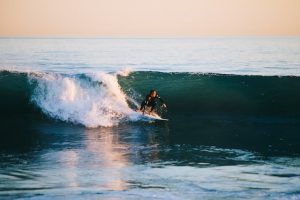So to start instruction on how to do a backside roundhouse cutback, we have to go back to one of my previous articles and remember that you must always follow your head and look where you want your board to go. Set the lip or white water as your target and don’t take your eyes off it until you hit it. Bottom line: under-the-lip snap, Alley Oops, round house cutties…any re-directional change really, requires that a surfer’s eyes remain fixed ahead where he wants the board to go; not down where the nose is pointed.
It’s a simple bit of knowledge that will change the way you surf for sure.
The backside roundhouse is a great maneuver for surfers when they want to stay in the power of the wave or are riding a gutless wave that is about to close out. Traditionally, the backside roundhouse was reserved for the shoulder where the wave loses most of its energy and begins to flatten out. Thus, a surfer needs a quick and stylish way to get back to the power of the whitewater. However, in modern surfing, surfers often turn to the backside roundhouse as a finishing move when a wave is too gutless for launching an air or throwing a big closeout hack through the lip.
Here’s how you do a backside roundhouse
First, catch the wave and pump out ahead of the white water. As you notice the wave beginning to fade on the shoulder, angle your board up towards the upper half of the wave so to take advantage of as much of the wave face that is left. It’s best to have as much speed as possible as you glide out on the shoulder, so be sure you have pumped hard off the bottom as you head out onto the shoulder.
Here is one issue with the roundhouse cutback, it is easy to glide too far out onto the shoulder. and be then left with too little speed to complete the maneuver. There is nothing worse than losing speed, digging rail, and losing the wave (okay there might be something worse, but I haven’t found it yet).
So once you are at full speed and gliding (anywhere from 8-15 feet ahead of the whitewater depending of wave size), bend your knees and angle your board at a 45-degree angle as you lift your leading shoulder and train your eyes on the direction you want the board to go. As you glide out on the shoulder of the wave (you should feel the wave begin to flatten out but don’t wait to turn until the wave has totally flattened), lean on the toe side of the board and turn your head to now train your eyes on the target area back in the white water. As you turn you will be applying equal pressure over the center of your board with equal reliance on your knees and lower back.
Add Your Style
Here is where the surfer can add stylistic nuances that will actually enhance the turn itself. Coiling the body (a little like Spider-Man) as you make your initial turn back towards the whitewater can add to the centripetal force you create as you extend your body upon re-direction change. Further, touching the water with your backhand really adds both a tactile element and a smooth look to your turn.
At this point, you should have more weight on your front foot as you race towards the oncoming section of whitewater. You approach this section as you would a closeout section with a bottom turn and a re-entry off the highest point of the wave. Depending how big the wave depends on how much juice you should brace for. The idea here is that you will use this ricochet power to propel you back onto the wave face and presumably into the reforming shoulder and onto the rest of the wave.
For less experienced surfers, aim lower on the whitewater so you can avoid the following pitfall.
One issue with rebounding off the white water after a roundhouse is that your board will often spin out of and lose momentum, risking you being knocked off your board by the oncoming wave. The key here is to have you weight centered over the center of your board so the focus is on staying upright, rather than falling back into some kind of layback.
Now, use your speed from the rebound to transition into the rest of the wave.



